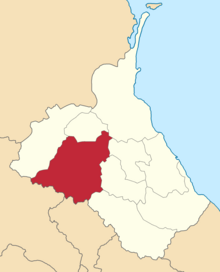Gunibsky okrug
Гунибскій округъ | |
|---|---|
 Location in the Dagestan Oblast | |
| Country | Russian Empire |
| Viceroyalty | Caucasus |
| Oblast | Dagestan |
| Established | 1860 |
| Abolished | 1928 |
| Capital | Gunib |
| Area | |
| • Total | 3,894.82 km2 (1,503.80 sq mi) |
| Population (1916) | |
| • Total | 76,175 |
| • Density | 20/km2 (51/sq mi) |
| • Rural | 100.00% |
The Gunibsky okrug[a] was a district (okrug) of the Dagestan Oblast of the Caucasus Viceroyalty of the Russian Empire. The area of the Gunibsky okrug is included in contemporary Dagestan of the Russian Federation. The district's centre was Gunib.[1][page needed]
The subcounties (uchastoks) of the Gunibsky okrug were as follows:[2]
| Name | 1912 population | Area |
|---|---|---|
| Andalyalskiy uchastok (Андаляльскій участокъ) | 14,623 | 312.69 square versts (355.86 km2; 137.40 sq mi) |
| Ants.-Kapuchinskiy uchastok (Анц.-Капучинскій участокъ) | 15,607 | 1,831.78 square versts (2,084.68 km2; 804.90 sq mi) |
| Kuyadinskiy uchastok (Куядинскій участокъ) | 10,076 | 256.95 square versts (292.43 km2; 112.91 sq mi) |
| Tilitl-Gidatlinskiy uchastok (Тилитлъ-Гидатлинскій участокъ) | 18,829 | 812.00 square versts (924.11 km2; 356.80 sq mi) |
| Tleyserukhskiy uchastok (Тлейсерухскій участокъ) | 14,443 | 1,108.91 square versts (1,262.01 km2; 487.26 sq mi) |
According to the Russian Empire Census, the Gunibsky okrug had a population of 37,639 on 28 January [O.S. 15 January] 1897, including 18,890 men and 18,749 women. The majority of the population indicated Avar to be their mother tongue.[3]
| Language | Native speakers | % |
|---|---|---|
| Avar-Andean | 52,227 | 93.43 |
| Kazi-Kumukh | 2,113 | 3.78 |
| Dargin | 774 | 1.38 |
| Russian | 376 | 0.67 |
| Ukrainian | 159 | 0.28 |
| Polish | 84 | 0.15 |
| Tatar[b] | 35 | 0.06 |
| Jewish | 33 | 0.06 |
| Kumyk | 17 | 0.03 |
| Lithuanian | 16 | 0.03 |
| Armenian | 10 | 0.02 |
| German | 8 | 0.01 |
| Georgian | 7 | 0.01 |
| Belarusian | 1 | 0.00 |
| Other | 39 | 0.07 |
| TOTAL | 55,899 | 100.00 |
According to the 1917 publication of Kavkazskiy kalendar, the Gunibsky okrug had a population of 76,175 on 14 January [O.S. 1 January] 1916, including 38,079 men and 38,096 women, 76,088 of whom were the permanent population, and 87 were temporary residents:[6]
| Nationality | Number | % |
|---|---|---|
| North Caucasians | 76,088 | 99.89 |
| Russians | 75 | 0.10 |
| Armenians | 6 | 0.01 |
| Other Europeans | 6 | 0.01 |
| TOTAL | 76,175 | 100.00 |